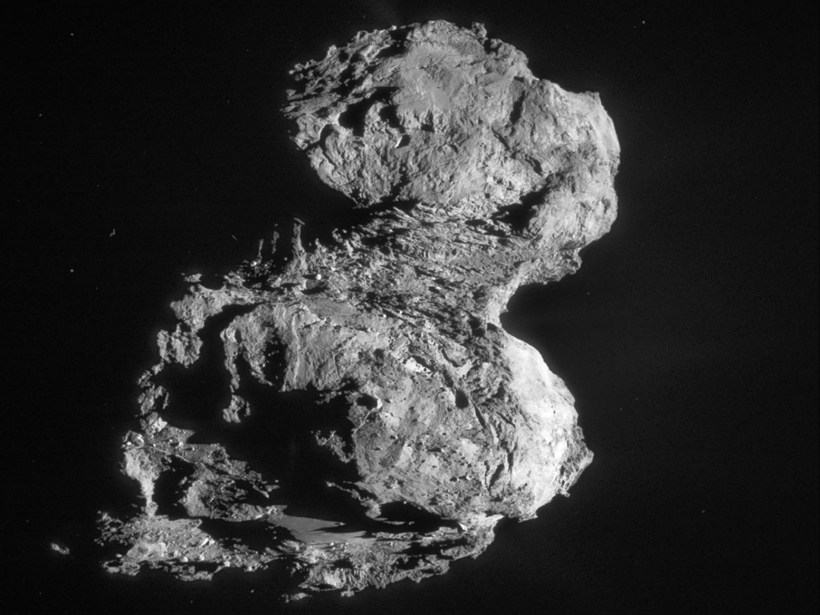A crack in the famous comet 67P/Churyumov-Gerasimenko is helping scientists explore mysteries of the solar system’s early days.
What could crack a comet?
Back in 2014, about a week after the European Space Agency’s Rosetta spacecraft entered orbit around the rubber duck–shaped comet 67P, mission scientists noticed a large crack on the comet’s surface. The crack was seen at the “neck,” where one bulbous region meets another.
Rosetta observed the crack as the comet was entering perihelion, its closest approach to the Sun. Onboard cameras observed the crack growing hundreds of meters in length. This event was unusually speedy, said Stubbe Hviid, a planetary scientist at the German Aerospace Center Institute of Planetary Research in Berlin, at a 17 October presentation at the meeting of the American Astronomical Society’s Division for Planetary Sciences.
The crack’s rapid growth mystified Rosetta scientists: What could crack a comet?
Comet Under Stress

Hviid and his colleagues suspected that stress on the comet might be to blame. So they built stress models of comet 67P, which involved calculating all the different stressors acting on the comet.
As the comet whirls through space, several different stressors act on it: Gravity tries to mold the body into a sphere—just like it did with Earth and other planets in the solar system—but the comet fights back (this is its tensile strength). Imagine a steel beam poking over the edge of a cliff: Gravity pulls the unsupported end down while the strength of the beam itself resists, Hviid said. Additionally, because the comet constantly spins, it’s “trying to fly apart” with centrifugal force, he continued.
And because of the comet’s odd shape, its “head” is perpetually trying to roll backward onto its “body” as it spins.
Their models revealed that indeed, all that stretching, pulling, and compressing could induce enough stress on the neck of the comet for it to crack, Hviid said.
Comet Origins
Modeling the different stressors on the comet also gave researchers a clue to its origins, Hviid said.
There are two main hypotheses of how comets form from the leftover dust of planet building. One, called the “primordial rubble pile,” states that comets come together from the tiny specks of material present in the then newborn solar system and are very, very old.
The other hypothesis, nicknamed the “collisional rubble pile,” proposes that chunks of rock first accreted from the dust. Much later, comets formed from those chunks smashing into each other over and over.
Comet 67P’s crack lends credence to the former theory that comets are loosely packed aggregates of very primitive, friable material, Hviid said. The crack offers evidence that the comet has little tensile strength compared to the other forces acting on it. That and other characteristics such as the comet’s high porosity (meaning the comet is mostly empty space) result in a very weak structure, like a fragile snowflake floating in space, Hviid said.
Scientists won’t get to see comet 67P up close again, but the crack gives them another clue to the puzzling origin of comets.
Such weak material as 67P contains would have shattered into little bits in the collisional scenario, Hviid suspects. He added that 67P’s very existence implies that there aren’t as many comets out beyond the solar system as was once thought: If there were as many objects as expected, there’d be a higher chance of collisions, which means comets as fragile as 67P couldn’t exist, Hviid said.
The Rosetta mission ended on 30 September of this year with Rosetta’s scheduled crash landing and Philae’s final goodbye. Scientists won’t get to see comet 67P up close again, but the crack gives them another clue to the puzzling origin of comets.
—JoAnna Wendel (@JoAnnaScience), Staff Writer
Citation:
Wendel, J. (2016), Cracking comet: A window to the past, Eos, 97, https://doi.org/10.1029/2016EO062381. Published on 01 November 2016.
Text © 2016. The authors. CC BY-NC-ND 3.0
Except where otherwise noted, images are subject to copyright. Any reuse without express permission from the copyright owner is prohibited.

